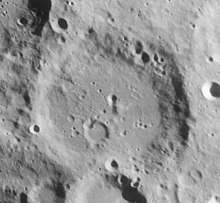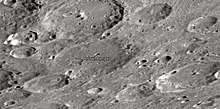Rosenberger (crater)
Rosenberger is an old lunar impact crater in the southeastern part of the Moon. It was named after German astronomer Otto August Rosenberger.[1]
 Lunar Orbiter 4 image | |
| Coordinates | 55.4°S 43.1°E |
|---|---|
| Diameter | 96 km |
| Depth | 2.2 km |
| Colongitude | 318° at sunrise |
| Eponym | Otto A. Rosenberger |
This crater is located in a region rich with prominent craters. The slightly smaller Vlacq is nearly attached to the northwestern outer rim of Rosenberger. Other nearby craters of note include Biela to the east, Hagecius to the south-southeast, and Nearch to the south-southwest. Due west past Vlacq is Hommel.

This crater has been heavily eroded by a history of impacts, so that the outer rim has become rounded and somewhat indistinct. As a result, the crater possesses only a shallow rise along the rim edge, and it nearly forms a circular depression in the surface. The satellite crater Rosenberger D, which is about 50 kilometers in diameter, intrudes into the southern rim of Rosenberger. A number of smaller, worn impact craters lie along the remainder of the rim and inner wall.
The interior floor of this crater forms a relatively level surface that is marked by several small craterlets. To the south-southeast of the midpoint is the worn remains of a small crater. At the midpoint there is a low central peak joined to a small craterlet to the north.
Satellite craters
By convention these features are identified on lunar maps by placing the letter on the side of the crater midpoint that is closest to Rosenberger.
| Rosenberger | Latitude | Longitude | Diameter |
|---|---|---|---|
| A | 53.5° S | 47.0° E | 49 km |
| B | 51.7° S | 46.1° E | 33 km |
| C | 52.1° S | 42.1° E | 47 km |
| D | 57.5° S | 42.9° E | 50 km |
| E | 59.3° S | 43.2° E | 11 km |
| F | 56.0° S | 40.6° E | 6 km |
| G | 53.9° S | 41.4° E | 9 km |
| H | 55.0° S | 46.5° E | 12 km |
| J | 52.9° S | 43.3° E | 22 km |
| K | 54.5° S | 47.7° E | 18 km |
| L | 52.6° S | 44.6° E | 9 km |
| N | 54.3° S | 44.1° E | 8 km |
| S | 55.8° S | 42.6° E | 14 km |
| T | 56.5° S | 43.1° E | 8 km |
| W | 58.7° S | 42.4° E | 32 km |
References
- "Rosenberger". Gazeteer of Planetary Nomenclature. International Astronomical Union. Retrieved 17 August 2017.
- Andersson, L. E.; Whitaker, E. A. (1982). NASA Catalogue of Lunar Nomenclature. NASA RP-1097.CS1 maint: ref=harv (link)
- Bussey, B.; Spudis, P. (2004). The Clementine Atlas of the Moon. New York: Cambridge University Press. ISBN 978-0-521-81528-4.CS1 maint: ref=harv (link)
- Cocks, Elijah E.; Cocks, Josiah C. (1995). Who's Who on the Moon: A Biographical Dictionary of Lunar Nomenclature. Tudor Publishers. ISBN 978-0-936389-27-1.CS1 maint: ref=harv (link)
- McDowell, Jonathan (July 15, 2007). "Lunar Nomenclature". Jonathan's Space Report. Retrieved 2007-10-24.CS1 maint: ref=harv (link)
- Menzel, D. H.; Minnaert, M.; Levin, B.; Dollfus, A.; Bell, B. (1971). "Report on Lunar Nomenclature by the Working Group of Commission 17 of the IAU". Space Science Reviews. 12 (2): 136–186. Bibcode:1971SSRv...12..136M. doi:10.1007/BF00171763.CS1 maint: ref=harv (link)
- Moore, Patrick (2001). On the Moon. Sterling Publishing Co. ISBN 978-0-304-35469-6.CS1 maint: ref=harv (link)
- Price, Fred W. (1988). The Moon Observer's Handbook. Cambridge University Press. ISBN 978-0-521-33500-3.CS1 maint: ref=harv (link)
- Rükl, Antonín (1990). Atlas of the Moon. Kalmbach Books. ISBN 978-0-913135-17-4.CS1 maint: ref=harv (link)
- Webb, Rev. T. W. (1962). Celestial Objects for Common Telescopes (6th revised ed.). Dover. ISBN 978-0-486-20917-3.CS1 maint: ref=harv (link)
- Whitaker, Ewen A. (1999). Mapping and Naming the Moon. Cambridge University Press. ISBN 978-0-521-62248-6.CS1 maint: ref=harv (link)
- Wlasuk, Peter T. (2000). Observing the Moon. Springer. ISBN 978-1-85233-193-1.CS1 maint: ref=harv (link)
| Wikimedia Commons has media related to Rosenberger (crater). |